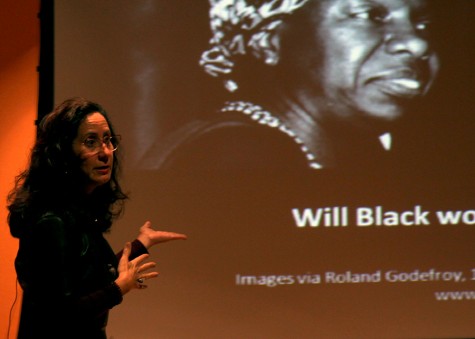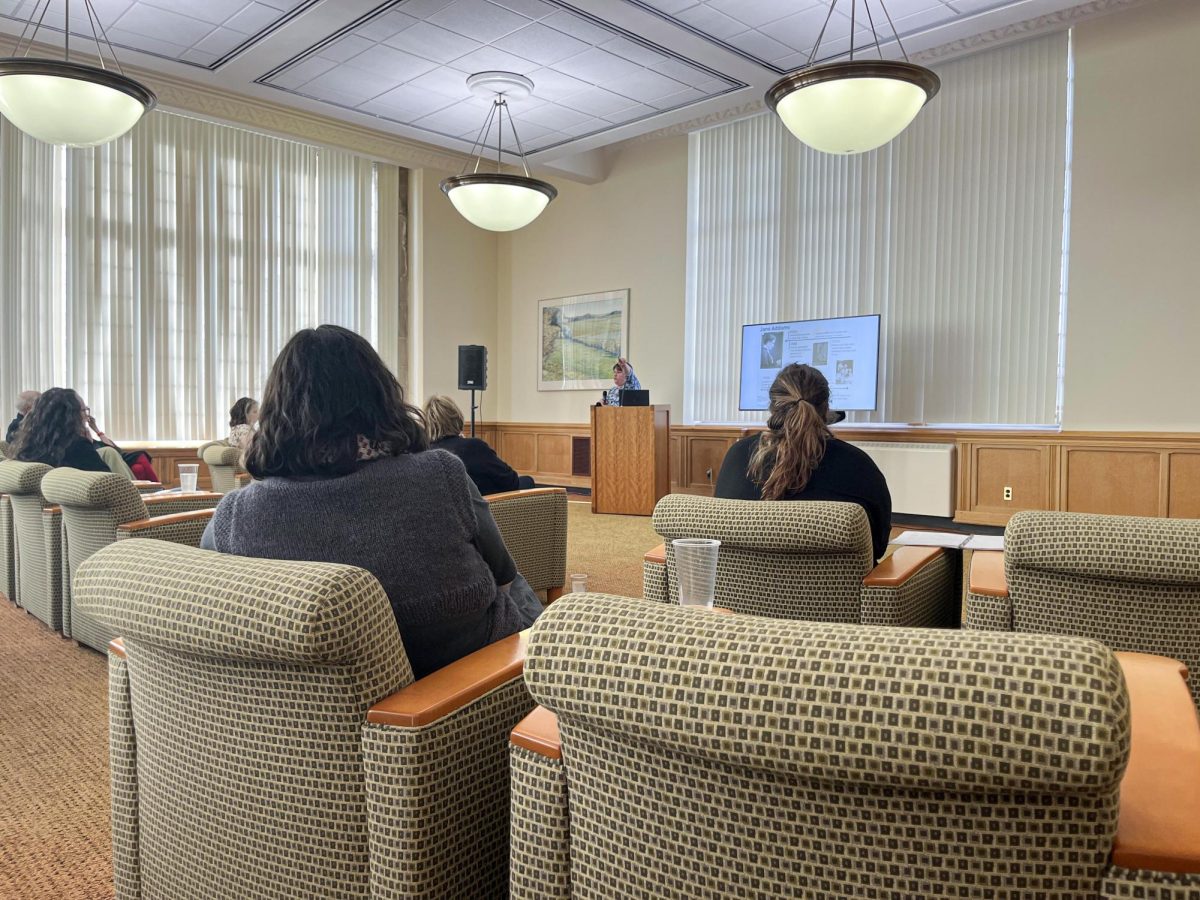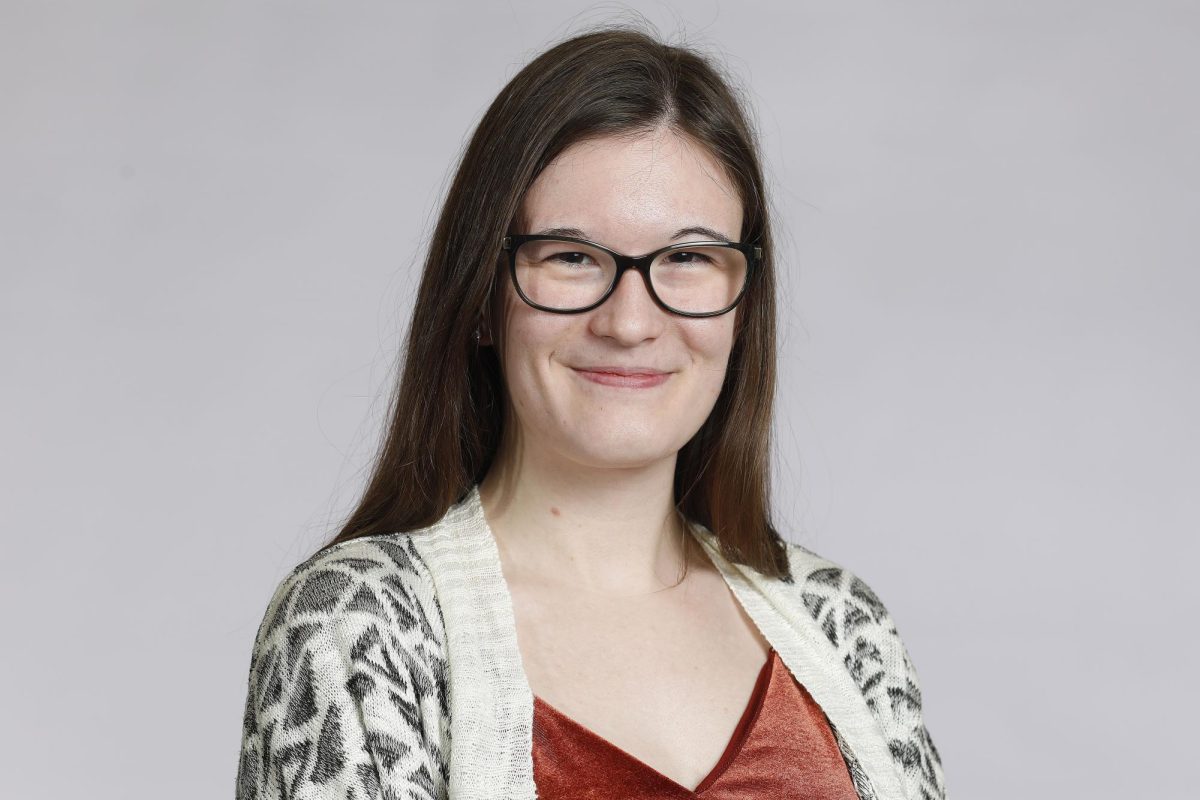Visiting professor debates media perception of Latinas
March 6, 2015
The hypersexuality of the Latin culture in mainstream American media was a topic for discussion Thursday evening.

Dr. Angharad N. Valdivia, an associate professor at the University of Illinois Urbana-Champaign, discusses gender and race issues displayed in the media at the Brain, Brow, or Bootie?: Contemporary Latinidad in Popular Culture presentation in the Doudna Fine Arts Center Thursday in the Lecture Hall. Dr. Valdivia mentions several examples in today’s society that are ambiguously placed in advertisements.
A lecture presented by Angharad Valdivia, as a part of Foreign Language Week 2015, opened up dialog on the issue.
Valdivia, a media and cinema studies professor at the University of Illinois Urbana-Champaign, is a transnational feminist scholar who co-wrote the research article “Brain, Brow, or Bootie? Contemporary Latinidad In Popular Culture.”
Valdivia said Latinos were finally being noticed in media when women like Jennifer Lopez and Frida Kahlo appeared in the entertainment industry.
Valdivia also explained how some mainstream and independent films attempt to represent the Latino community, but portray a story negatively and often fail in the box office.
“They are underrepresented either in front of or behind a camera,” Valdivia said.
Valdivia said Latina Americans often play a different nationality by altering their physical appearance.
“In order for Sophia Vergara to crossover mainstream, she had to dye her hair brown because she was a blonde,” Valdivia said, “She wouldn’t make it as a mainstream actress without (having) brown hair.”
Valdivia also said Vergara and Jennifer Lopez have idolized Latina bodies.
Valdivia said she found eight overlapping patterns, frequently found in the media.
One of the patterns is Erasure, where one ethnicity is excluded and is not established in the media. Valdivia used the examples of the shows “Friends” and “The Brady Bunch.” She said ethnic variety is eliminated in those shows.
Another pattern was Binary, where Latino Americans are found in shows, but star as a side ethnic character to the other “token” minority on the show.
“Ambiguous ethnics” are used heavily, Valdivia said.
An “ambiguous ethnic” is someone who is hard to characterize in a specific minority group.
Valdivia explained that often in advertising a sequence in races are found, Americans reads left to right, so often an African-American is positioned in a photo or advertised on the left, ambiguous races stand in the middle.
Keila Ortiz, a sophomore family and consumer major, said she was not aware of some of the things in the media occurred.
“It was informative because we don’t have discussions like this on campus,” Ortiz said, “We Latinas are perceived as showing our bodies, but its not always like that.”
Valdivia also reviewed the topic of how children networks work towards a broader audience.
“Channels want to maximize profit so, they can make more with ambiguous characters but reach out to the white community,” Valdivia said.
Valdivia used examples like “Cheetah Girls” and “Lizzie McGuire.”
“It’s difficult to say media over culture because culture is media. The media does not work on its own,” Valdivia said.
Valdivia said the sexuality of Latina Americans, African-Americans and Asian-American women differ.
“Latinas are represented as hypersexual and hyper fertile. The Asian body is shown as pliable,” Valdivia said, “In terms of African-American women sexuality in the U.S., it’s displaced, not as sexually desirable but sexually aberrant.”
The topic of a newly-aged generation Latina was also mentioned.
Valdivia said women born with African-American and Latin descent are called Afro-Latina.
Afro-Latina, Zoe Saldana is playing the role of an African-American singer Nina Simone and in order to play that role she has to darken her skin, Valdivia said.
“Hollywood has displaced any sexually femininities to women of color,” Valdivia said, “Latinos and other minorities seek a rightful place in the culture.” Valdivia said.
Jeannie Ludlow, a coordinator of Women’s Studies, said this is what Eastern needed considering this is Women’s History Month. Ludlow also said she was taken back by some of the topics discussed.
“To see her made-up like that broke my heart because that’s a cultural history we are supposed to move from,” Ludlow said, “It feels like every time we do something better in terms of race, we take steps backward and we’re back to where we were at again.”
T’Nerra Butler can be reached at 581-2812 or tabutler@eiu.edu.









![[Thumbnail Edition] Eastern Illinois University baseball's hitting coach and recruiting coordinator Mike Pugliese urges players on the team to increase their effort after a slow start to its pregame routine at the team's first intrasquad scrimmage of the season at O'Brien Field on Jan. 31, 2025.](https://www.dailyeasternnews.com/wp-content/uploads/2025/03/BB_02_O-1-e1741909628540-1200x702.jpg)
![[Thumbnail Edition] Senior tennis player Luisa Renovales Salazar hits the tennis ball with her racket at the Darling Courts at the Eastern Illinois University campus in Charleston, ILL.](https://www.dailyeasternnews.com/wp-content/uploads/2025/03/Tennis_01_O-1-e1741807434552-1200x670.jpg)
![[Thumbnail Edition] Senior right-handed pitcher Tyler Conklin pitching in the Eastern Illinois University baseball team's intrasquad scrimmage at O'Brien Field in Charleston, Illinois on Jan. 31.](https://www.dailyeasternnews.com/wp-content/uploads/2025/03/TC_01_O-e1741567955534-1200x669.jpg)





![[Thumbnail Edition] Senior, forward Macy McGlone finds an open teammate to pass the ball too during the game against the Tennessee State Tigers 69-49, in Groniger Arena on the Eastern Illinois University campus, Charleston Ill.](https://www.dailyeasternnews.com/wp-content/uploads/2025/03/WBB_02_O-1-e1741228987440-1200x692.jpg)


















![E[Thumbnail Edition] Eastern Illinois softball freshman utility player Abbi Hatton deciding to throw the softball to home plate in a fielding drill during softball practice at the field house in Groniger arena on Tuesday Feb. 11.](https://www.dailyeasternnews.com/wp-content/uploads/2025/03/SB_03_O-e1741208880750-1-e1741209739187-1200x815.jpg)















![The Weeklings lead guitarist John Merjave [Left] and guitarist Bob Burger [Right] perform "I Am the Walrus" at The Weeklings Beatles Bash concert in the Dvorak Concert Hall on Saturday.](https://www.dailyeasternnews.com/wp-content/uploads/2025/03/WL_01_O-1200x900.jpg)
![The team listens as its captain Patience Cox [Number 25] lectures to them about what's appropriate to talk about through practice during "The Wolves" on Thursday, March 6, in the Black Box Theatre in the Doudna Fine Arts Center in Charleston, Ill.](https://www.dailyeasternnews.com/wp-content/uploads/2025/03/WolvesPre-12-1200x800.jpg)





















